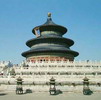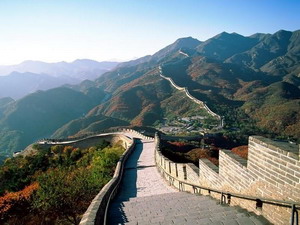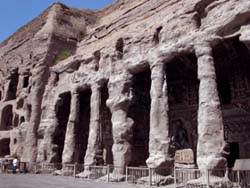| Day 1 Beijing ( ) |
| Our English speaking tour guide will hold a welcome sign to waiting for you at Beijing Capital Airport according to your international (internal) flight schedule. Transfer to the hotel and relax for the rest of the day. |
Beijing | As the center of politics, cultural and international exchange, Beijing is a modern metropolis full of vitality.
For the history buffs, Beijing is a living museum, but it has something to offer everyone. It is also the starting point for most of our China vacations. |
|
 |
| [ Optional ] Dashilan old street: Dashilan is the oldest and perhaps one of Beijing’s most fascinating streets to explore. This district is cluttered South of Tian'anmen Square, it is the civilian area, known as the grassroots culture under the Forbidden City. |
|
| Day 2 Beijing ( B,L,D ) |
| Visit those famous attractions in Downtown Beijing. At night, enjoy the typical local entertainment - Beijing Opera, a combination of acrobats and traditional costumes show. |
Temple of Heaven | It was the place where the Emperor of the Ming and Qing dynasties would worship heaven and pray for good harvests. Built first in 1420, the Temple of Heaven is a precious example of China 's ancient architectural art and the largest design for worshipping heaven in the world. | Tian An Men Square | As the largest city plaza in the world, it is of great cultural significance for its seeing of several key events in Chinese history. Today here are always sightseers and kite-flyers. Most visit at dawn or dusk to see the flag raising and lowering conducted by the PLA. | Peking Opera | With a history of 160 years, Peking Opera, extolled as “Oriental Opera”, is representative of all operas in China. Full of Chinese cultural traditions and tidbits, the opera presents the audience with touching stories, beautiful paintings, exquisite costumes, graceful gestures and martial arts. | Forbidden City | For almost 500 years, the Forbidden City served as the home of 24 Emperors and their households, and the ceremonial and political center of the Chinese imperial government. It was listed by UNESCO as a World Cultural Heritage Site in 1987. |
|
 |
| [ Optional ] Peking Roast Duck: With its long history, Peking roast duck is well known among both domestic and overseas customers. The duck is hung in the oven and roasted by flame burning from fruit-wood. It takes about 45 minutes for the duck to be done. The finished duck is characteristic with crispy skin, tender meat and the fragrance from the fruit-wood. |
|
| Day 3 Beijing ( B,L ) |
| Whole day tour to Mutianyu Great Wall and Ming Tombs. |
Sacred Way | It was originally built to lead to Changling Tomb as a symbol of the passed emperor’s journey to heaven in their afterlife. Alongside the Sacred Road are 12 pairs of animal marble figures such as lions, elephants and 6 pairs human marbles such as generals and public officials. | Ming Tombs (Changling) | Changling Tomb is the largest and the most well-preserved one of the 13 Ming Tombs. Emperor Zhu Di, the third emperor of Ming Dynasty, and his Empress are co-buried in this grave. The 32 giant pillars in the Ling’en Hall, Changling’s main building, remain as solid as before after over 500 years. | Mutianyu Great Wall | Mutianyu Great Wall seems to be not popular as section at Badaling, but it doesn’t get as crowded, which assist you in appreciating the magnificent scenery easily. Woods cover over 96% of the total scenic area, and its 2.5 kilometer stretch allows you a walk with striking landscape and fresh air. |
|
 |
| [ Optional ] Lao She Tea House: Lao She Tea House is one of Beijing's most famous tea house, and has been visited by a number of well-known politicians. It is a wonderful entertainment house with short shows by comedians, singers, musicians, acrobats and opera performers. |
|
| Day 4 Beijing, Datong ( B,L ) |
| After our Hutong visiting, we'll transfer to Beijing train station to catch the train to Datong. The train is about 6 hours (soft sleeper). Train No.: K615 (leave Beijing at 14h57, arrive Datong at 20h50) Pick up at Datong railway station and drive to the hotel. |
Train K615 Beijing to Datong | K615 train is running on routes Beijing West Train Station to Datong. Train No.: K615 (leave Beijing at 14h57, arrive Datong at 20h50). These trains have soft class with 4-berth ordinary soft class sleepers, 6-berth hard class sleepers and hard seats, only public toilet (prpare toilet tissue by you…… | Hutong Tour | The Hutongs is the old narrow paths where common people used to live. You will be taken by rickshaws to visit ordinary Beijing families living in these compound houses. Rickshaws are actually three wheeled bicycles. There are fleets of them circling around the Hutongs. |
|
 |
| [ Optional ] Datong: Datong is situated in northern Shanxi Province. It was the political, economic and military center of ancient North China. With a history of over 2400 years, Datong was the capital of Northern Wei (386~534) for 96 years, and the 'support capital' of Liao (916~1125) and Jin (1115~1234). |
|
| Day 5 Datong ( B,L ) |
| Drive 7km to visit Yungang Grottoes in the morning. Drive 90 minutes (69 km) to see Hanging Temple and Wooden Pogoda in Yinxian county (75km south of Datong). It takes about 8 hours for today's sightseeing. |
Hanging Temple | Hanging Temple stands at the foot of Mt. Hengshan, 5 kilometers (3 miles) south of Hunyuan County, and 65 kilometers (40 miles) from downtown Datong City. | Yungang Grottoes | Yungang Grottoes, one of the three major cave clusters in China, punctuate the north cliff of Wuzhou Mountain, Datong. The area was excavated along the mountain, extending 1 km (0.62 miles) from east to west, revealing 53 caves and over 51,000 stone statues. | Wooden Pagoda in Yingxian | Located in Yingxian County, and about 70 kilometers south of Datong, the Wooden Pagoda is the oldest and highest wooden structure in China. It is regarded as the 'First Pagoda in the World' and a gem in the architectural field. It has now also been placed under national emphases under the Cultural R…… |
|
 |
| [ Optional ] Datong food: Datong is mainly famous for its various wheaten food. Local people put wheat, pea, buckwheat, soybean sprout, tofu and peanut into boiling cooking pot, add vinegar together, and this type of noodle soup will be their main dish, 3 times everyday. People never get tire of foods made of noodle, and I was told that there are more than 100 kind of different noodle soups, with dozens of different seasoning. |
|